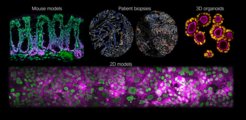Biophysical Regulation of Cell State Dynamics
Miroshnikova Lab
Research Vision
Our laboratory employs interdisciplinary approaches to uncover the role of mechanical forces in regulating chromatin and nuclear architecture and gene expression patterns to ultimately tune cell state. We collaborate with mathematicians, physicists, clinicians, and engineers with the aim of uncovering the fundamental principles behind cellular decision-making.

Tissues, cells, and organelles are continuously exposed to a multitude of mechanical forces that deform and induce changes in nuclear shape and volume, thus completely remodeling the nuclear mecahno-osmotic environment and macromolecular crowding. Given the critical role of the three-dimensional organization of chromatin in transcriptional regulation, it is critical to understand how these mechano-osmotic changes that occur during processes such as cell motility, polarization, and differentiation trigger specific changes in gene expression. Furthermore, nuclear shape and size abnormalities, in combination with chromatin distribution, are routinely utilized by clinicians to diagnose various cancers, highlighting the importance of detecting irregularities in nuclear shape. Yet, what precisely determines nuclear shape in health and disease, and how this is linked to cell fate and function remains a fundamental open question. Our laboratory addresses these key questions using 2- and 3-dimensionsional in vitro culture models of adult and induced pluripotent stem cells, organoids, mouse models, and bioreactors and engineered system mimicking a number of topological and mechanical inputs that resemble physiological and pathological stimulation.
Recent Research Highlights
- Uncovered a mechanosensitive checkpoint at the nuclear envelope and revealed a new role for the chromatin-lamina interface as a checkpoint of genome integrity with fundamental implication to aging and cancer (Hervé, Scelfo et al., Nat Cell Biol 2025)
- Established a mechanochemical feedback mechanism that integrates nuclear mechanics, shape and volume regulation with biochemical signaling and chromatin state to tune the probability of cell fate transition dynamics (McCreery, Stubb et al., bioRxiv 2024)
- Discovered a novel mechanism by which nuclear deformation triggers chromatin architecture changes to alter nuclear mechanics and to protect cells from DNA damage (Nava, Miroshnikova et al., Cell 2020).
- Deciphered how biomechanical signaling through cell-cell and cell-ECM interactions within a multilayered tissue specifies dynamic coupling of cellular position with fate (Miroshnikova et al., Nat Cell Biol 2018)
